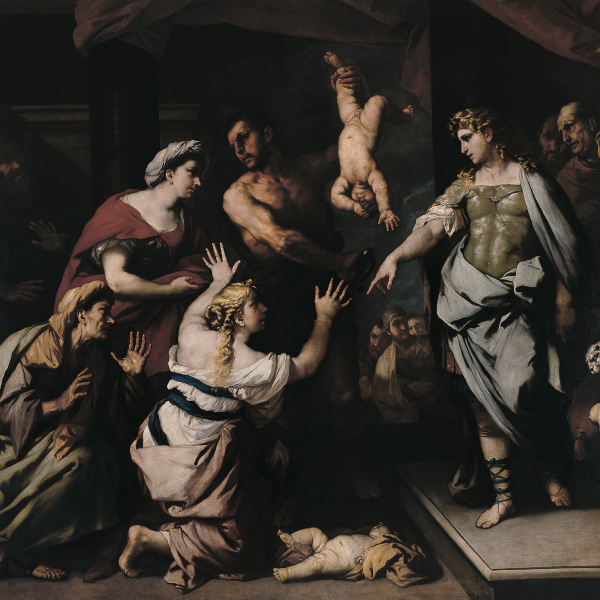Luca Giordano
Nápoles, 1632 -1705
Luca Giordano, whose father Antonio was also a painter, was first schooled in the tradition of Ribera's powerful naturalism. However, Giordano soon left Naples, possibly following the death of the great Spanish master in 1651, and travelled to Rome, Florence and Venice in order to further his studies. Giordano's work seems clearly linked, though perhaps only in an ideal sense, to that of Pietro da Cortona in Rome, the great master whose 16th-century sources Giordano came to know in Venice. Titian, in particular, inspired the bursts of colour in his earliest works, both Venetian (The Virgin and Child and the Purging Souls, c. 1650, San Pietro di Castello) and painted elsewhere (Saint Thomas of Villanova Distributing Alms, The Ecstasy of Saint Nicholas of Tolentino, 1658, in Sant'Agostino degli Scalzi in Naples). In 1653, Giordano was once again in Naples, rapidly forming an original stylistic blend that drew on Ribera, on 16th-century Venetians (The Holy Family with the Symbols of the Passion, in the church of Santi Giuseppe e Teresa in Pontecorvo, 1660), on Mattia Preti (The Burial of Christ, Detroit Institute of Arts, c. 1660), and on Flemish artists, primarily Van Dyck and Rubens (Saint Januarius Liberates Naples from the Plague in Santa Maria del Pianto in Naples, c. 1660), whom he most likely studied in Neapolitan private collections.
In 1664 the artist was once again in Florence, working for the Medici, as well as in Venice. Back in Naples in 1665, in 1667 he painted The Assumption of the Virgin for Santa Maria della Salute and in the following decade executed the fresco for the dome of Santa Brigida (1678) and the Life of Saint Gregory the Armenian in the church of the same name (c. 1678-1679), also sending three altarpieces to Venice for the church of Santa Maria della Salute. By now a celebrated artist, on a trip to Florence in 1682, Giordano painted the dome of the Corsini chapel in the church of the Carmine and he began the frescoes for the Gallery and the Library of the Medici-Riccardi palace, his masterpiece, which he returned to complete in 1685. The splendour and naturalism of this project amounted to a declaration of his indebtedness to the work and style of Pietro da Cortona. Giordano lived in Naples for several years, but in 1692 his international fame as an artist was consummated by the invitation to be court painter to Charles II of Spain. His output over the course of the following decade exceeds what other artists could have achieved in a lifetime. Leaving aside his production of altarpieces and religious fresco cycles (for example, the frescoes in San Antonio de los Portugueses, Madrid, or those in the Monastery de Nuestra Señora de Guadalupe), suffice to say that there is hardly a royal building that was not touched by the Neapolitan's brushstrokes: El Escorial, the Casón del Buen Retiro, the Sacristy of the Cathedral of Toledo, etc. In 1702, following the death of Charles II, Giordano returned home to Naples via Livorno. In the remaining four years of his enormously productive life he completed a huge number of commissions (including the canvases for Santa Maria Egiziaca at Forcella and The Meeting between Saint Charles Borromeo and Saint Philip Neri in the church of the Girolamini, in 1704). Standing above all his other works are his decorations of the Chapel of the Treasury for the Charterhouse of San Martino, completed in 1704. Giordano died before his was able to complete the frescoes for the sacristy of the church of Santa Brigida. These were finished by his pupils based on his sketches.
Roberto Contini
In 1664 the artist was once again in Florence, working for the Medici, as well as in Venice. Back in Naples in 1665, in 1667 he painted The Assumption of the Virgin for Santa Maria della Salute and in the following decade executed the fresco for the dome of Santa Brigida (1678) and the Life of Saint Gregory the Armenian in the church of the same name (c. 1678-1679), also sending three altarpieces to Venice for the church of Santa Maria della Salute. By now a celebrated artist, on a trip to Florence in 1682, Giordano painted the dome of the Corsini chapel in the church of the Carmine and he began the frescoes for the Gallery and the Library of the Medici-Riccardi palace, his masterpiece, which he returned to complete in 1685. The splendour and naturalism of this project amounted to a declaration of his indebtedness to the work and style of Pietro da Cortona. Giordano lived in Naples for several years, but in 1692 his international fame as an artist was consummated by the invitation to be court painter to Charles II of Spain. His output over the course of the following decade exceeds what other artists could have achieved in a lifetime. Leaving aside his production of altarpieces and religious fresco cycles (for example, the frescoes in San Antonio de los Portugueses, Madrid, or those in the Monastery de Nuestra Señora de Guadalupe), suffice to say that there is hardly a royal building that was not touched by the Neapolitan's brushstrokes: El Escorial, the Casón del Buen Retiro, the Sacristy of the Cathedral of Toledo, etc. In 1702, following the death of Charles II, Giordano returned home to Naples via Livorno. In the remaining four years of his enormously productive life he completed a huge number of commissions (including the canvases for Santa Maria Egiziaca at Forcella and The Meeting between Saint Charles Borromeo and Saint Philip Neri in the church of the Girolamini, in 1704). Standing above all his other works are his decorations of the Chapel of the Treasury for the Charterhouse of San Martino, completed in 1704. Giordano died before his was able to complete the frescoes for the sacristy of the church of Santa Brigida. These were finished by his pupils based on his sketches.
Roberto Contini





